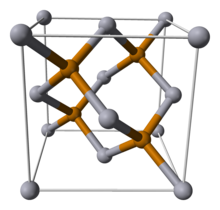Mercury telluride

| |
| Names | |
|---|---|
| Systematic IUPAC name Mercury telluride | |
| Other names Mercuric telluride, mercury(II) telluride | |
| Identifiers | |
3D model (JSmol) |
|
| ECHA InfoCard | 100.031.905 |
| EC Number |
|
PubChem CID |
|
CompTox Dashboard (EPA) |
|
| |
| |
| Properties | |
| HgTe | |
| Molar mass | 328.19 g/mol |
| Appearance | near black cubic crystals |
| Density | 8.1 g/cm3 |
| Melting point | 670°C |
| Structure | |
| Sphalerite, cF8 | |
| F43m, No. 216 | |
Except where otherwise noted, data are given for materials in their standard state (at 25 °C [77 °F], 100 kPa). | |
Mercury telluride (HgTe) is a binary chemical compound of mercury and tellurium. It is a semi-metal related to the II-VI group of semiconductor materials. Alternative names are mercuric telluride and mercury(II) telluride.
HgTe occurs in nature as the mineral form coloradoite.
Physical properties
All properties are at standard temperature and pressure unless stated otherwise. The lattice parameter is about 0.646 nm in the cubic crystalline form. The bulk modulus is about 42.1 GPa. The thermal expansion coefficient is about 5.2×10−6/K. Static dielectric constant 20.8, dynamic dielectric constant 15.1. Thermal conductivity is low at 2.7 W·m2/(m·K). HgTe bonds are weak leading to low hardness values. Hardness 2.7×107 kg/m2.[1][2][3]
Doping
N-type doping can be achieved with elements such as boron, aluminium, gallium, or indium. Iodine and iron will also dope n-type. HgTe is naturally p-type due to mercury vacancies. P-type doping is also achieved by introducing zinc, copper, silver, or gold.[1][2]
Topological insulation

Mercury telluride was the first topological insulator discovered, in 2007. Topological insulators cannot support an electric current in the bulk, but electronic states confined to the surface can serve as charge carriers.[5]
Chemistry
HgTe bonds are weak. Their enthalpy of formation, around −32kJ/mol, is less than a third of the value for the related compound cadmium telluride. HgTe is easily etched by acids, such as hydrobromic acid.[1][2]
Growth
Bulk growth is from a mercury and tellurium melt in the presence of a high mercury vapour pressure. HgTe can also be grown epitaxially, for example, by sputtering or by metalorganic vapour phase epitaxy.[1][2]
Nanoparticles of mercury telluride can be obtained via cation exchange from cadmium telluride nanoplatelets.[6]
See also
References
- ^ a b c d Brice, J. and Capper, P. (eds.) (1987) Properties of mercury cadmium telluride, EMIS datareview, INSPEC, IEE, London, UK.
- ^ a b c d Capper, P. (ed.) (1994) Properties of Narrow-Gap Cadmium-Based Compounds. INSPEC, IEE, London, UK. ISBN 0-85296-880-9
- ^ Boctor, N.Z.; Kullerud, G. (1986). "Mercury selenide stoichiometry and phase relations in the mercury-selenium system". Journal of Solid State Chemistry. 62 (2): 177. Bibcode:1986JSSCh..62..177B. doi:10.1016/0022-4596(86)90229-X.
- ^ Spencer, Joseph; Nesbitt, John; Trewhitt, Harrison; Kashtiban, Reza; Bell, Gavin; Ivanov, Victor; Faulques, Eric; Smith, David (2014). "Raman Spectroscopy of Optical Transitions and Vibrational Energies of ~1 nm HgTe Extreme Nanowires within Single Walled Carbon Nanotubes" (PDF). ACS Nano. 8 (9): 9044–52. doi:10.1021/nn5023632. PMID 25163005.
- ^ König, M; Wiedmann, S; Brüne, C; Roth, A; Buhmann, H; Molenkamp, L. W.; Qi, X. L.; Zhang, S. C. (2007). "Quantum Spin Hall Insulator State in HgTe Quantum Wells". Science. 318 (5851): 766–770. arXiv:0710.0582. Bibcode:2007Sci...318..766K. doi:10.1126/science.1148047. PMID 17885096. S2CID 8836690.
- ^ Izquierdo, Eva; Robin, Adrien; Keuleyan, Sean; Lequeux, Nicolas; Lhuillier, Emmanuel; Ithurria, Sandrine (2016-08-12). "Strongly Confined HgTe 2D Nanoplatelets as Narrow Near-Infrared Emitters". Journal of the American Chemical Society. 138 (33): 10496–10501. doi:10.1021/jacs.6b04429. ISSN 0002-7863. PMID 27487074.
External links
- Thermophysical properties database[permanent dead link] at Germany's Chemistry Information Centre, Berlin
